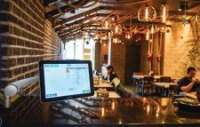By Jurgen Ketel, Managing Director EMEA, Givex
It's been nearly four years since McDonald's first started to use self-service ordering kiosks in its restaurants, as a part of building what it termed the "experience of the future". Considering that the average purchase is, according to research, 20% higher when ordering from a self-service kiosk compared to ordering from a human server, it comes as no surprise that the company is rolling this out to all of its 15,000 restaurants in the US, as well as its key global markets.
And it's not just McDonald's - nor just fast food restaurants - that can stand to benefit from this technology. Kiosks are slowly proliferating throughout other types of restaurants (think casual dining, cafés and bistros) as well as the wider world of retail. A report by Transparency Market Research projects that the global kiosk market will expand at a combined annual growth rate of 10.9 percent over the next seven years, topping $30.8 billion by 2024.
So it's safe to assume that if you haven't considered kiosks for your restaurant business yet, you might want to soon. Some might believe that kiosks remove the human element of going to a restaurant, but there are advantages for customers that go beyond the human touch. They include:
Less judgement: All orders and transactions are private, so customers don't have to feel judged, influenced or pressured over what they order.
Improved customer experience: Kiosks are an extension of your brand. They are designed to be a continuation of the experience, not a standalone feature. You can personalise the interface, which means you won't need to compromise your branding.
More convenience: Kiosks keep queues moving. And when customers can move through the line even faster, they're generally much happier.
Greater accuracy: The anxiety induced by a waiter not writing down your order disappears with kiosks. Guests are assured that their orders will be processed accurately because they are directly involved in processing an order via the kiosk, and that perception can help improve a restaurant's overall customer experience.
But the convenience and advantages of kiosks aren't just reserved for the customer. Merchants also benefit from:
Reduced human error: With kiosks, there are no miscommunication or language barriers. Reduced errors during the ordering process also results in reduced food waste.
A maximised labour force: Kiosks allow employees to maximise their time with other tasks and means you can better manage costs, too.
More productive front-line staff: If employees aren't tied to the front counter or the register, they can focus their efforts on providing an excellent customer experience and engaging with guests.
Insightful data: Interactive features like opinion polls and surveys can be built into kiosks to give customers a chance to leave valuable feedback and for you to gain a deeper insight into each guest.
Drive uplift at the checkout: Studies have shown that consumers tend to purchase more and try new products when using technology to make their purchase. Ultimately, kiosks make it easier to automatically promote new products and encourage additional sales with special offers.
Of course, kiosks aren't going to be a perfect fit for every type of restaurant. They're primarily suited for quick-service and casual dining establishments where the emphasis is more on convenience than bedside manner. And even those that do introduce them to their restaurants need to retain an essential element of ‘humanness' in customer service. They need to restructure how human labour is used and move away from simple order taking to more customer experience-focused responsibilities. Luckily, kiosks grant staff the time to come up with ideas for better service.
Kiosks can make restaurants more efficient, benefitting both the customer and the merchant. If you haven't considered using one yet, now might be the time to start.





